How Do Teachers Integrate STEM into K-12 Classrooms?
A research team led by Michigan Technological University set out to find what makes STEM integration tick
 Teachers who integrated engineering design projects, like this landslide model, observed higher engagement from their students.Photo courtesy of Michigan Tech
Teachers who integrated engineering design projects, like this landslide model, observed higher engagement from their students.Photo courtesy of Michigan Tech
New teaching standards call for weaving science, technology, engineering, and math (STEM) into classrooms better. What makes this integration effective?
A research team led by Michigan Technological University set out to find what makes STEM integration tick. Their research—published in the International Journal of STEM Education (DOI: 10.1186/s40594-018-0101-z)—followed several case studies to observe the impacts of low, medium, and high degrees of integration within a classroom. They found that across the board the greatest challenge that teachers face is making explicit connections between STEM fields while balancing the need for context and student engagement.
Emily Dare, assistant professor of STEM education at Michigan Tech, is lead author of the study. She says different teachers have different approaches to STEM integration.
“This alone is not terribly surprising, as we know that teachers conceptualize integrated STEM in multiple ways,” Dare says. “What is new about this current study is that this degree of integration may be related to a teacher's understanding in making explicit and meaningful connections between the disciplines, as opposed to assuming that students will make those connections on their own.”
Teachers start to implement Next Generation Science Standards (NGSS)
Although the call for improving STEM education is widespread, like in the NGSS, there is little guidance for teachers on how to do so.
Dare and her co-authors—Joshua Ellis of Michigan Tech and Gillian Roehrig of the University of Minnesota—worked with nine middle school science teachers to assess STEM integration in their classrooms. The researchers relied on both reflective interviews with the teachers and classroom implementation data, like the number of instructional days dedicated to two or more disciplines and the amount of time given to each discipline.
“The teachers who integrated more often in their class appeared to be more critical of their instruction,” Dare says, “And after their first time implementing integrated STEM instruction, they were already considering ways in which to improve their practice.”
She explains that this speaks volumes about teachers' motivation and dedication to incorporating these approaches in their classrooms: If they find the integrated approach valuable, they may be more willing to spend time helping students make those content connections.
STEM education calls for connecting science, technology, engineering and math
Three themes arose from the results of Dare and her collaborators’ work that distinguished low, medium and high STEM integration.
First, the nature of integration varied; that is, the role teachers perceived they should play in making explicit or implicit connections. A more active role in making connections reflected higher integration, though not without its challenges. Previously, Dare led research helping to clarify what STEM education, and therefore integration, means in practical terms for teachers.
Related Article: Education System Failing to Properly Prepare STEM Students for the Working World
Second, classroom integration depended on whether a teacher chose to focus primarily on science or engineering. Dare and her team argue that science versus engineering is a false choice. Teachers with higher degrees of STEM integration wove in science concepts throughout engineering design projects, like connecting lessons on heat transfer and insulators to building solar ovens. Across the board, design-based projects tended to happen in the last few days of instruction. Teachers with lower degrees of integration tended to focus on the science first then shift completely into engineering.
Third, student engagement played a role—and an important one. Students tended to be motivated for engineering design projects; teachers explained that the work provided context, making the concepts more real and understandable. The challenge is that teachers felt pressed to balance the hands-on work with conceptual and reflective activities. Plus, maintaining a contextual example over several weeks became difficult.
Classroom challenges—and how to overcome them
The paper authors point out that while the study subjects are middle school physical science teachers doing first-time STEM instruction, many of the identified themes are not content-specific. Because of that, the successes and challenges identified may shed light on general struggles that are common to educators who are integrating across STEM disciplines under new teaching standards.
Teachers’ primary challenges focused on trying to keep the lessons real for students and struggling to better integrate math. Dare suggests this may be because science teachers are just that—not math teachers or engineers.
“For teacher educators,” Dare says, “this means continuing to support teachers in their classrooms as they embark on testing out new strategies and curriculum units in their classrooms.”
To effectively integrate science, technology, engineering and math in K-12 education, it will take more than a sequence of lesson plans—it will mean playing with tech and engineering design projects that dovetail with math and science ideas for a well-rounded STEM classroom.
Michigan Technological University is a public research university, home to more than 7,000 students from 60 countries around the world. Founded in 1885, the University offers more than 120 undergraduate and graduate degree programs in science and technology, engineering, forestry, business and economics, health professions, humanities, mathematics, and social sciences. Our beautiful campus in Michigan’s Upper Peninsula overlooks the Keweenaw Waterway and is just a few miles from Lake Superior.
